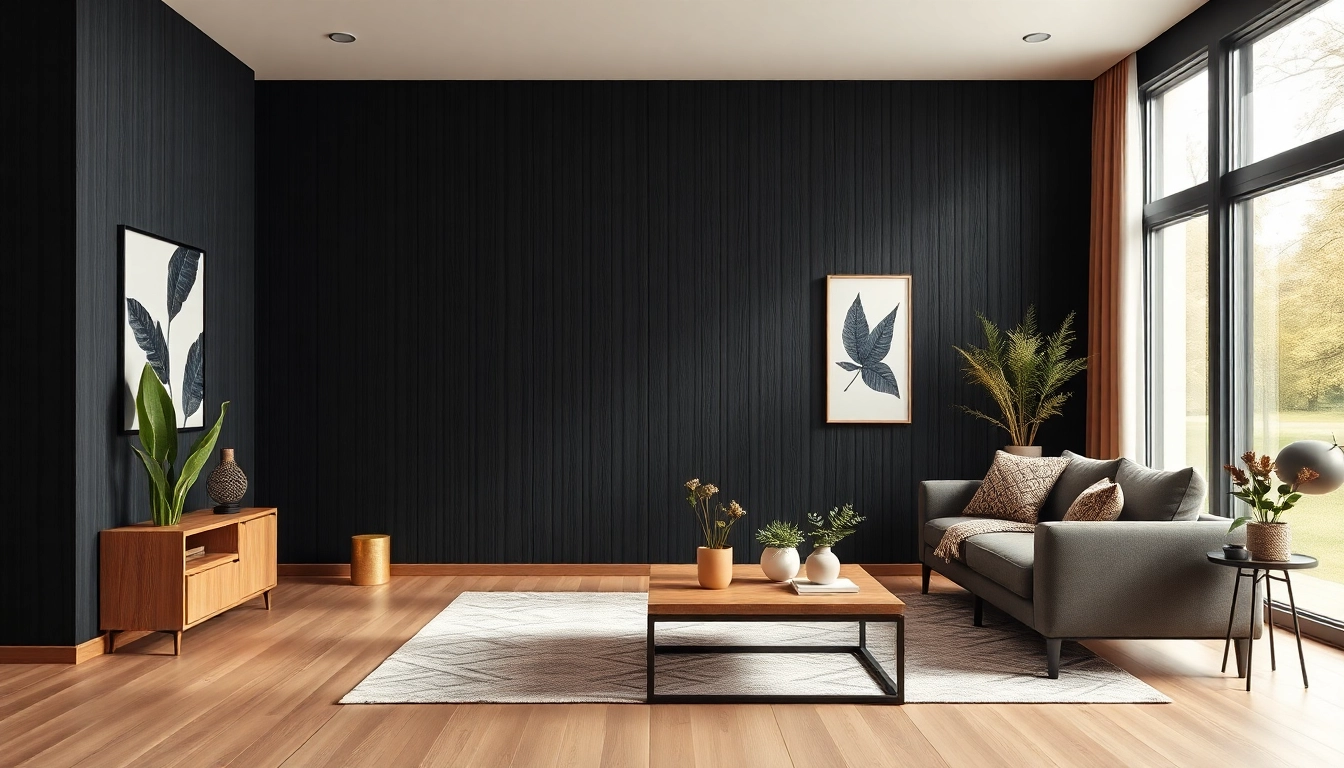Understanding Black Wall Paneling
What Is Black Wall Paneling?
Black wall paneling is a type of wall treatment that adds depth, drama, and sophistication to interiors. Made from various materials such as wood, MDF, or even vinyl, these panels are often designed to cover entire walls or sections, providing a striking contrast to lighter decor elements. The finish can range from matte to glossy, allowing homeowners and designers to create personalized aesthetics. By opting for black wall paneling, you can transform an ordinary space into a visually captivating environment.
Benefits of Using Black Wall Paneling
The appeal of black wall paneling lies in its versatile nature and numerous benefits:
- Aesthetic Appeal: The rich, dark hue exudes elegance and sophistication, making spaces feel more upscale and modern.
- Versatility: Black wall paneling complements various design styles, from contemporary to traditional, making it suitable for virtually any space.
- Enhanced Space Perception: When applied correctly, black paneling can create the illusion of depth, making rooms feel larger and more dynamic.
- Durability: Many types of black wall paneling, particularly those made from solid wood or high-quality composites, are designed for longevity and can withstand wear and tear.
- Sound Insulation: Wall panels can also help in soundproofing a space, making it quieter and more private.
Different Types of Black Wall Paneling
There are several types of black wall paneling, each offering unique characteristics:
- Wood Paneling: Natural wood paneling in black stain showcases grain patterns, providing an organic feel. This type can be used in both rustic and modern designs.
- MDF Paneling: Medium-Density Fiberboard (MDF) offers a smooth finish and is easy to paint, making it a cost-effective option for achieving the black wall paneling look.
- Vinyl Wall Panels: These panels are versatile and often more lightweight than wood, available in various designs, including embossed finishes that mimic textured materials.
- Shiplap and Tongue & Groove: These traditional styles can add texture and interest to a room through various orientations, creating a contemporary twist on classic designs.
Choosing the Right Black Wall Paneling for Your Space
Factors to Consider When Selecting Black Wall Paneling
Selecting the right black wall paneling involves several important considerations:
- Room Size: In smaller spaces, opt for panels that are more lightweight or have a glossier finish to reflect light and create an illusion of space.
- Lighting: The type and amount of natural light in a room can dramatically affect the appearance of black panels. Consider the placement of windows and choose finishes that will enhance the lighting.
- Texture: Mixing textures is a great way to deepen the aesthetic experience. Combining smooth black panels with rougher or patterned elements can create a visually appealing contrast.
- Functionality: Consider the purpose of the room. For example, in a home office, acoustically-focused panels may be beneficial, while in a dining room, aesthetic appeal may take precedence.
Matching Black Wall Paneling with Your Interior Style
When integrating black wall paneling, it’s essential to align it with your existing design elements:
- Modern Minimalism: Pair sleek, flat-panel designs with clean lines and minimal decor to maintain simplicity.
- Industrial Style: Contrast rough materials like metal and concrete with raw wooden black paneling for an authentic industrial atmosphere.
- Traditional Elegance: Use ornate, decorative black panels in conjunction with classic furnishings and accessories.
- Bohemian Vibe: Mix and match colorful decor elements and textures to coast alongside the boldness of black wall panels.
Common Mistakes to Avoid with Black Wall Paneling
Many homeowners make mistakes when incorporating black wall paneling; here are some to avoid:
- Overuse of Black: Using too much black can overwhelm a space. Balance it with lighter elements or contrast it with vibrant colors for visual relief.
- Neglecting Lighting: Failing to consider lighting can lead to a dull atmosphere. Ensure that the space is well-lit to showcase the beauty of the black panels.
- Inconsistent Styles: Mixing too many competing styles can create confusion. Ensure that the black wall paneling fits cohesively within the overall design theme.
- Wrong Finish Selection: Choosing a matte finish for high-traffic areas can lead to wear more easily. Select finishes that are suited for the room’s function.
Installation Tips for Black Wall Paneling
Tools and Materials Required for Installation
Successful installation of black wall paneling requires the right tools and materials. Here’s a checklist:
- Wall panels (black wood, MDF, or vinyl)
- Measuring tape
- Level
- Stud finder
- Adhesive or nails (depending on the type of panel)
- Saw (if trimming is needed)
- Caulk or wood filler (for finishing touches)
- Paint or stain (if necessary)
Step-by-Step Installation Guide
Here’s a simple step-by-step guide to help you install black wall paneling:
- Measure and Plan: Begin by measuring the wall area you wish to cover. Create a layout plan, noting the number of panels needed.
- Prepare the Wall: Ensure the wall is clean, dry, and free from blemishes. Fill any large holes and smooth the surface.
- Locate Studs: Use a stud finder to mark where the studs are located. This is crucial for securing panels properly.
- Cut Panels to Size: If necessary, trim the panels to fit your layout using a saw.
- Start Installing Panels: Begin in a corner or the top of the wall. Use adhesive or nails, securing each panel to the wall and ensuring they are level.
- Seal Gaps: After all panels are installed, use caulk or wood filler to seal gaps between panels for a finished look.
- Finish Touches: Paint or stain any exposed edges and clean the surface to remove dust or debris.
Hiring Professionals vs. DIY Installation
Deciding whether to hire professionals or tackle installation as a DIY project depends on several factors:
- Skill Level: If you have experience with home improvement projects, DIY can be a rewarding challenge, but ensure you’re confident in your abilities.
- Budget: DIY might save you money, but hiring professionals guarantees expert installation that can prevent costly mistakes.
- Time Constraints: If you’re pressed for time, professionals can execute the job efficiently, freeing you from the installation process.
Maintaining Your Black Wall Paneling
Cleaning and Care for Black Wall Paneling
Proper maintenance of black wall paneling enhances its longevity and appearance. Here’s how:
- Regular Dusting: Use a microfiber cloth to regularly dust the surface and prevent a buildup of dirt and grime.
- Gentle Cleaning: For more thorough cleaning, use a damp cloth with mild detergent. Avoid abrasive cleaners that can damage the finish.
- Wipe Spills Immediately: Accidental spills can stain black paneling, especially on matte finishes, so wipe them up promptly.
Repairing White Spots and Damage
Over time, you may notice wear on your black wall paneling. Here are some tips on repair:
- Identify the Damage: Assess the type of damage, whether it’s scratches, white spots, or dents.
- For Scratches: Use a matching wood or furniture pen to touch up the scratch and make it less visible.
- For White Spots: These may indicate moisture damage. Lightly sand the area and apply a matching stain or paint to disguise the defect.
- Full Panel Replacement: In severe cases, replacing an entire panel may be necessary for uniformity.
Longevity Tips for Black Wall Paneling
To ensure your black wall paneling lasts, consider these longevity tips:
- Control Humidity: High humidity levels can cause warping. Utilize dehumidifiers in areas prone to moisture.
- Avoid Direct Sunlight: Sunlight can fade and damage finishes. Use curtains or shades to protect paneling from excessive exposure.
- Regular Inspections: Routinely check for signs of wear, moisture damage, or pests, addressing any issues promptly.
Inspirational Ideas for Using Black Wall Paneling
Creative Ways to Incorporate Black Wall Paneling
Black wall paneling can serve numerous design goals. Here are some creative ideas:
- Accent Walls: Use black paneling on a single wall to serve as a striking accent that draws attention.
- Ceiling Treatment: Enjoy dramatic flair by extending black paneling to the ceiling, creating a cozy yet expansive ambiance.
- Backdrops: Create functional beauty by using black wall paneling as a backdrop for art or shelving, enhancing visual interest.
Case Studies: Successful Black Wall Paneling Designs
Here are examples where black wall paneling has been successfully implemented:
- Contemporary Living Room: In a recent refurbishment, a designer used black MDF panels in a herringbone pattern to create a focal wall that contrasts with light wood accents, enhancing the room’s depth.
- Elegant Dining Space: A dining room featuring black wooden panels adds a timeless elegance when paired with gold accents and rich fabrics, transforming the space into a luxurious haven.
Integrating Decor with Black Wall Paneling
To maximize the appeal of your black wall paneling, consider these integration strategies:
- Color Pops: Introduce colorful decor through furniture, art, or accessories to create eye-catching contrasts.
- Layered Textures: Combine varied textures, such as soft fabrics and hard materials, with the black paneling to evoke depth and interest.
- Lighting Accents: Employ strategic lighting, including sconces or spotlights, to enhance the features of the black wall paneling.



